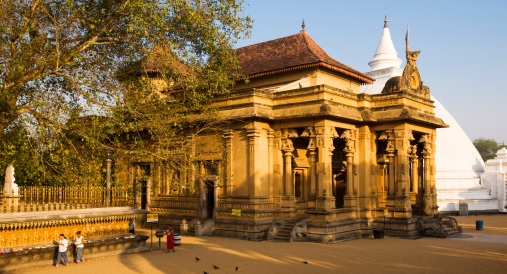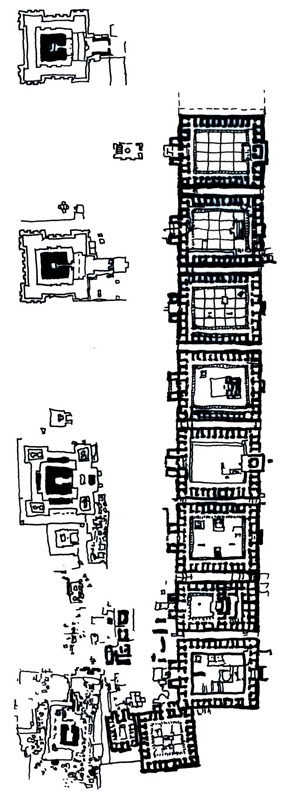Dec 14, 2025
Dec 14, 2025

Kelaniya Raja Maha Vihara., Colombo, Sri Lanka
... Recent Knowledge on Its Architecture and Etymology
There is a curious resemblance between the modern day word ‘Bihar’ (a state in India) and the Buddhist, or Pali, word for the seclusion centers where Buddhist monks used to stay. This word, ‘Vihara’, possibly meant ‘refuge’ or dwelling’ or even ‘a place to stay’, and the typology originally came into use to shelter wandering Buddhist monks from the vagaries of the weather. In its initial, early form, Buddhism did not permit the use of iconography and images of the Buddha and so viharas by definition are bereft of all but the most simple iconography and images, preferring instead to reflect the reclusive life of their inhabitants.
In the 4th century BC when the Buddha actually lived, there was little need for permanent shelters, since most of the monks lived a wandering life. It was only later on, at around the 2nd century BC, when the development of the janapada kingdoms and the appearance of a rich merchant class, accompanied with development of lucrative trade routes into the hinterland of Asia and Persia, that enough money become available for some of the early rich converts to Buddhism to equip the monasteries with endowments that made possible an upgrade from temporary, thatched wooden structures (as indicated in an earlier article ‘The Vedic House’) to a more permanent abode.
There were two types of Viharas developed, though both types followed the same standard plan. The first was a stand-alone, structural building (more common in South India) and the second was a rock cut vihara hewn into the side of a mountain or a hill, as can be found in central India with the chaitya structures in the Deccan.
Plan Form and History
The Deccan plateau in India is home to some of the earliest chaityas and viharas, some dating as early as the 3rd or even the 4th century BC. While we see in these viharas and chaityas a struggle to evolve a distinct plan form, some of the most common features are elaborate pillars, doorway arches and ornate facades. Endowed by wealthy merchants, these viharas and chaityas benefited from the trade routes across Asia towards Roman territory.
The later chaitya finds its plan form stabilizing. In brief it consists of a pillared archway on the door, a central court with or without pillars marking its periphery, and three rows of secluded cells with narrow, low doorways ringing the court’s perimeter. There is very little in the way of sources of light, except from the main entrance itself. The overall effect is that of seclusion and penance, as exhorted by the principal tenets of Mahayana Buddhism, whose precepts the monks were serving.

The difference between these early rock cut viharas and the later free standing ones in Bengal and Bihar, for example, is that the latter have four rows of cells, not three, around a free standing courtyard. Later examples became more complicated, with rows of adjunct and ancillary buildings marking the appearance of a complex of buildings reflecting the increasingly complex life of the Buddhist monastery, which changed in function from a simple abode for monks to an administrative and educational center, the prime example being that of the Buddhist university at Nalanda in Bihar, which attracted scholars from regions as far as China and south east Asia.
 These accounts have been witnessed by the Chinese travelers Xuanzuang and Hsieun-Tsang, who also noted the appearance of a stupa containing relics of the Buddha at the end of the vihara. It has been said that viharas and chaityas, however ornate they became in the late era of Buddhism, never totally forgot their roots from wood structures and that the stone carvings and indeed the structure was reflecting this nuance. However it must also be said that Buddhism by its very nature is a very plastic religion compared to the rigid tenets of the late Vedic religion, and some of this playfulness on the exterior facades and interior spaces of the later Vihara and chaitya structures may simply have been a response to this playfulness and a desire to differentiate between the nascent religion and the overwhelming presence of the dominant religion.
These accounts have been witnessed by the Chinese travelers Xuanzuang and Hsieun-Tsang, who also noted the appearance of a stupa containing relics of the Buddha at the end of the vihara. It has been said that viharas and chaityas, however ornate they became in the late era of Buddhism, never totally forgot their roots from wood structures and that the stone carvings and indeed the structure was reflecting this nuance. However it must also be said that Buddhism by its very nature is a very plastic religion compared to the rigid tenets of the late Vedic religion, and some of this playfulness on the exterior facades and interior spaces of the later Vihara and chaitya structures may simply have been a response to this playfulness and a desire to differentiate between the nascent religion and the overwhelming presence of the dominant religion.
Later viharas, among them Vikramshila, Nalanda, Odantapura and Jaggadara became still more complex with Buddhism achieving the status of a ‘state religion’. By now the vihara complexes were under central administration with the buildings and structures, far apart though they were, acting in concert under councils of monks.
What happened to these famed Viharas and chaitya complexes later? With later Hinduism having successfully absorbed Buddhism by the logical technique of making the Buddha part of the Hindu pantheon of dashavatara or the ‘ten avatars’, the importance of the monastic complexes decreased. New trade routes and new patterns of living may also have played a role in the decline of Buddhism in India. With the coming of the Gupta dynasty and the building of increasingly magnificent Hindu temples in the region, Buddhism declined further. However the places of learning continued to retain their prestige over the ages, and new and recent attempts in modern day Bihar to revive the university of Nalanda as a modern institution testify to the continued relevance of the legacy of Buddhism in India – as a fount of learning and principles, rather than a living religion whose torch has since passed elsewhere in Asia.
Image (c) Gettyimages.com
15-Oct-2013
More by : Ashish Nangia

|
Good account. very informative. Will appreciate elaboration on pre-Buddhist origin of chaityas, as worship places of Yakhsas and some Hindu deities. |